Here is the list of the 7 best turkey breeds for meat farming with the comparison and advantages, challenges of rearing them.
Turkey farming is becoming more and more familiar around the globe. Some folks are even considering this business as an alluring alternative to full-time jobs.
However, this sudden boom to this sector has brought its own unique set of challenges.
The most burning question for the newbies roams around the turkey breed. Undoubtedly, this is the first thing you need to decide if you are considering farming turkey.
Once you have mastered this topic, you can concentrate on the next step. Without any further ado let’s directly jump into the learning part!
Ensure a Jump Start with The Best Breeds for Turkey Farm Business!
- Broad Breasted Whites
- Blue Slate Turkey
- Black Turkey
- Bourbon Reds
- Beltsville Small White
- Midget White
- Narragansett
1. Broad Breasted Whites
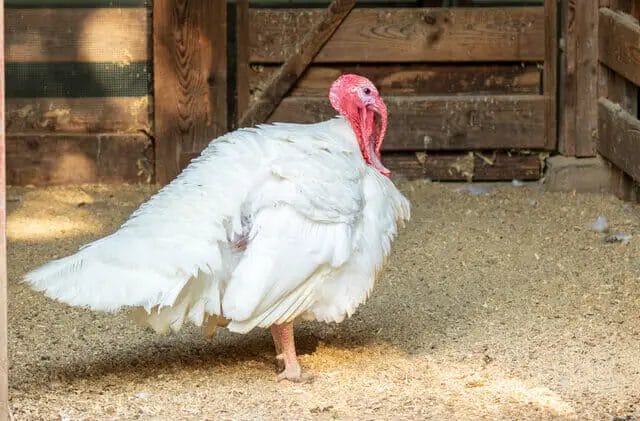
This breed was introduced back in the 1960s and gained popularity. These turkeys have relatively shorter bones in the breast. As a result, they have broader breasts.
This configuration is suitable for commercial meat production. These turkeys are equally popular even today.
Origin
Broad breast turkeys were ‘developed’ by a human being. They are the result of crossing White Holland with Broad Bronze Turkey. It was originated in the USA and, no wonder, most Americans are love this type of turkeys.
Advantages
Broad Breasted Whites have all of the elements that are needed to be commercially successful. They have a bigger body that ensures more meat. Besides, they are relatively easy to raise. An average broad breast turkey can grow up to 40 lbs.
Starting a farm business with this turkey is relatively easy. More and more enterprises are showing interest in this breed. As a result, collecting the resources is not a difficult task.
You can find mature turkeys at a relatively higher price. But buying old poults is an option to save bucks.
These turkeys typically need more nutritious food compared to other breeds for better growth. Finding the proper diet for these turkeys is not difficult. You can even get customized turkey food with a high nutrition rate.
Challenges
You have to encounter some unique challenges while raising broad breasts. They are meant to be food. So, they lack some survival qualities. They cannot fly because of their heavyweight.
Besides, they face some issues regarding this fatty body. Some of these birds may encounter joint and heart-related issues that can shorten their lifespan.
To encounter this problem you need to come up with a full-proved strategy. This starts with the selection of meals and extends up to proper housing. Fortunately, more people are getting involved in this niche. They have formed a community that can be helpful for you to seek solutions.
Summary
| Primary use: | Meat production |
| Natural Breeding: | Possible |
| Insemination: | Possible |
| Weight: | 38-40 lbs. |
2. Blue Slate Turkey

Blue slates were first domesticated in Mexico about 2000 years ago. Blue slates were a common sight in North America. But now this breed is considered endangered species and is even on the ‘watch’ category of the Livestock Breeds Conservancy.
Origin
This breed is also commonly known as ‘Slate Turkey’ or ‘Lavender Turkey’. Most of the authors in the past were inclined to classify this breed as a cross between the white and black turkey breeds.
But modern science can find very little evidence to prove that. Rather it presents a complicated idea of several mutations.
Physical Appearance
Blue slate turkeys are known for their quite distinctive looks. Even the hens and toms are different in colors, color shades to be precise.
Hens show a lighter hue than their male counterparts. This breed process an overall attractive look than the previous two.
Advantages
The average lifespan of a blue slate turkey is 5-9 years. They can grow up to 27 lbs. Currently, they are raised as pets and often become the attraction of pet exhibitions.
However, they are considered a great source of delicious meat. It means they have a relatively good potential for commercial farming.
Summary
| Primary use: | Pet, meat production |
| Natural Breeding: | Possible |
| Insemination: | Possible |
| Weight: | 18-27 lbs. |
3. Black Turkey
‘Norfolk Black’ and even the ‘Black Spanish turkey’ are nothing but Black turkey. This breed has a long story to tell. The Europeans originally bred these turkeys.
European explorers brought this breed to the USA. Evidence shows that this breed is in America since the 1500s.
Origin
Europeans are responsible for familiarizing this breed all over the world. These turkeys are considered a great source of meat in the United Kingdom. Besides, these are equally popular in Spain.
Perhaps, this is the reason that has brought the name ‘Black Spanish Turkey’.
Advantages
Black turkeys are of medium size. The toms can weigh up to 23 lbs. and the hens can grow up to 14 lbs. Historically Black turkey is considered a great source of meat. As stated before, people want to taste this bird even today.
For this existing and increasing demand for farming, this breed is a lucrative option for farm entrepreneurs. Moreover, black turkeys are fit for almost all types of climates.
It means it is less prone to climate-related diseases and related hassles.
Like the previous breed, black turkeys can naturally mate. Insemination is also an option. But this process needs careful monitoring for better results.
Summary
| Primary use: | Meat production |
| Climate: | Almost all climate |
| Natural Breeding: | Possible |
| Insemination: | Possible |
| Weight: | 14 lbs. (hens), 23 lbs. (toms) |
4. Bourbon Reds
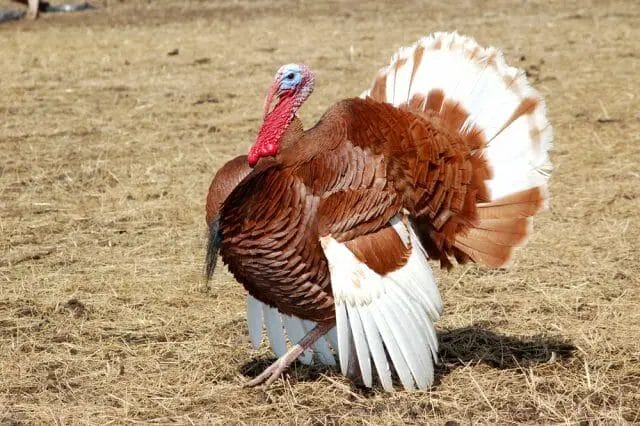
Bourbon Reds turkeys bear the heritage of their origin. ‘Bourbon’ stands for its primary origin. This breed was first hatched in Bourbon County in Kentucky in the 1800s.
At first, it was known as “Bourbon Butternuts.” Later it was renamed ‘Bourbon Red’ that better represents its physical appearance.
Origin
In the 1800s a man named J. F. Barbee developed this breed from Buff, Bronze, and White Holland turkeys.
Though its name bears Bourbon, the initial steps took place in Pennsylvania. After some iterations and selections, Barbee was able to achieve a sustainable breed.
Advantages
This breed has thrived between the 1930s and 1940s. Its glory was faded away because of the commercial inclination towards more effective breeds. But at present, this breed is considered one of the wanted retro breeds in the USA.
Bourbon Reds are known as a reliable source of meat. They can grow up to 33 lbs. (toms) and 18 lbs. (hens).
But the most fascinating fact is that they can search for their foods. So, the overall cost of raising these turkeys is not high.
They can breed naturally if a correct ratio of hens and toms is maintained. Besides, you can cross it with similar breeds.
Some of these crosses are docile and some are a bit aggressive. The breeder has full control over the nature of the cross.
Summary
| Primary use: | Pet, meat production |
| Natural Breeding: | Possible |
| Insemination: | Possible |
| Weight: | 18 lbs. (hens), 33 lbs. (toms) |
5. Beltsville Small White
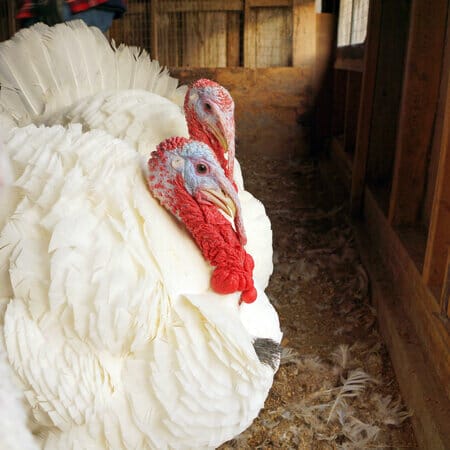
This is a breed that bears the name of its origin. It’s a breed that was ‘engineered’ in a research lab. Back in the 1930s, the primary goal of this project was to meet the market need.
Researchers in USDA’s Beltsville Agricultural Research Center was tasked to come up with a smaller version of turkey for smaller families. Moreover, the goal is to ‘design’ a breed that can be processed easily.
This good option for smaller families couldn’t attract commercial usages. Folks in the hotel, restaurant chain, and the ‘meat processors’ wanted something big. This commercial push made Beltsville Small White turkeys obsolete by the 1970s.
Origin
Beltsville Small White shares the same generic family from which the Narragansett, White Holland, White Austrian, Bronze as well as Wild Turkey come from. Beltsville Small Whites were the foundation of some later small flocks.
Present Condition
According to the American Livestock Breeds Conservancy, this breed is now considered as ‘critical’. Some flocks are being raised in restricted areas at present. So, mass-market usages of these turkeys are limited.
Luckily, the farming of these turkeys is gaining speed in the private sector.
Folks who want to taste something slightly different are big fans. Besides, measures have been taken to preserve this breed across the USA and Canada.
Advantages
The main use of this type is to get meat, no doubt. The hen can grow up to 10 lbs. and the toms can be 17 lbs. Though these are not that social as some other turkey breeds, you can count on their docile nature.
These turkeys can breed naturally. Besides, insemination is also possible. These turkeys can be raised in different climates. They are less prone to diseases.
Summary
| Primary use: | Meat production |
| Climate: | Almost all climate |
| Natural Breeding: | Possible |
| Insemination: | Possible |
| Weight: | 10 lbs. (Hen), 17 lbs. (Tom) |
6. Midget White
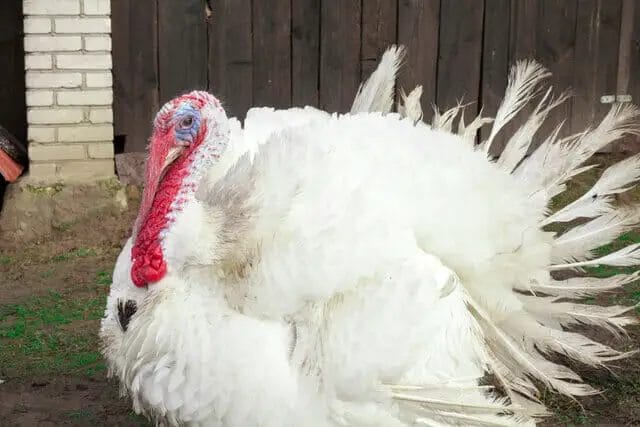
This is another breed that was ‘developed’ during the 60s. During the period scientists did some research on commercially viable turkeys. As a result, this breed emerged along with some other breed. But these turkeys remained a niche breed for a long.
Origin
Midget whites are often considered as a compliment to Beltsville Small White turkeys. Both of these breeds showcase almost similar characteristics but they have come from different origins.
This particular breed has a close tie with white commercial turkeys and Royal plums.
Advantages
These turkeys are not that much bigger. They can be called bigger chickens. Toms are 13 lbs. while hens are 8-10 lbs. roughly. It can be considered as a ‘miniature version’ of broad-breasted whites. Both of the breeds have similar broad breasts.
However, Midget Whites have an attractive appearance that makes them good pets. But they are not far behind in meat production.
This breed can be a considerable source of meat. It can provide a great experience by ensuring a change of regular taste. That’s why this has created a good customer base.
Summary
| Primary use: | Meat production, pet |
| Climate: | Almost all climate |
| Nature: | Docile |
| Insemination: | Possible |
| Weight: | 13 lbs. (toms), 8-10 lbs. (hens) |
7. Narragansett
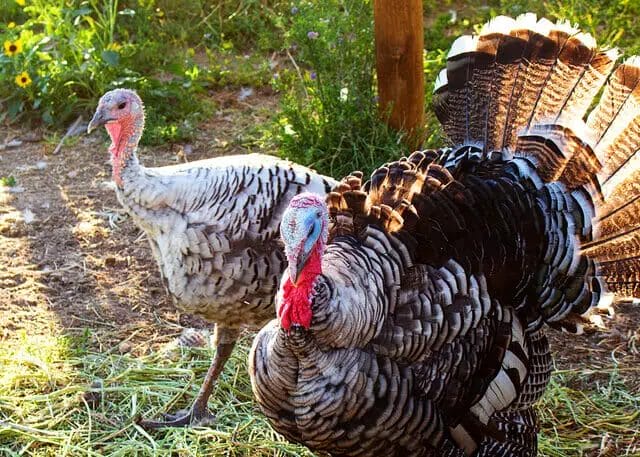
This breed is a unique cross between wild turkeys and docile turkeys (Norfolk turkeys). This is a home breed of the United States and possesses some unique historical values. This is the basis of turkey farming in some states.
Origin
This breed also bears the name of its origin. It was developed in Narragansett Bay. Before the 1900s, these turkeys had a considerable demand. Later the focus was shifted towards standard bronzes.
Advantages
Average Narragansett turkey can grow up to 23 lbs. (toms) and 14 lbs. (hens). They are well known for their domestic nature. Besides, they can be the source of delicious meat.
As these turkeys have some excellent qualities regarding natural sustainability, they can be raised easily.
These turkeys get mature relatively early in their lives. Besides, they exhibit much immunity against diseases.
For all of these reasons, they need a much less professional touch. That’s why they can be a great addition to a family farm or similar smaller farms.
Summary
| Primary use: | Pet, meat production |
| Natural Breeding: | Possible |
| Insemination: | Possible |
| Weight: | 23 lbs. (toms), 14 lbs. (hens) |
Final Verdict
Raising turkeys is not a niche farming task to do now. Rather it is being more and more commercialized and different communities are emerging. You can start farming with any of the breeds mentioned above.
These are relatively common breeds, to begin with. Besides, they all promise a great return. Later you can add more breeds to your farm that can diversify your investment.
